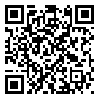Volume 2, Issue 162 (7-2021)
J Except Educ 1400, __(162): 109-109 |
Back to browse issues page
1- M A in Clinical Child and Adolescent psychology, Faculty of Educational Sciences and Psychology, Tabriz University, Tabriz, Iran , abdolrahimpour_r@yahoo.com
2- Prof in Psychology, Dep. of Education and Psychology, Tabriz University, Tabriz, Iran
2- Prof in Psychology, Dep. of Education and Psychology, Tabriz University, Tabriz, Iran
Abstract: (3337 Views)
Abstract
Background & Purpose: Externalizing behavioral disorder are one of the most common childhood
psychiatric disorders. Among the psychological components that are affected in these children are
executive functions and empathy. Therefore, the aim of this study was to investigate inhibition, response,
sustained attention and dimensions of empathy in children with behavioral disorders
Method: The present study is descriptive and causal-comparative. The statistical population included
elementary school students (ages 8 to 12 years old) in Tabriz in the academic year of 2019-2020. To collect
the data, the Teacher Form Children’s Symptoms Questionnaire, Stroop and Continuous Performance
Tests, and the Dods Empathy Scale were used. The results were analyzed by multivariate analysis of
variance in SPSS20 software.
Results: The results showed that response inhibition, sustained attention, cold and hot empathy in children
with externalized behavioral disorder were less pronounced than in children without disturbances.
(F= 40/57, P< 0/05).
Conclusion: It can be concluded that executive functions and empathy in children with externalized
behavioral disorders are impaired. Identifying and understanding these factors can help to better understand
this disorder and offer different treatment strategies.
Background & Purpose: Externalizing behavioral disorder are one of the most common childhood
psychiatric disorders. Among the psychological components that are affected in these children are
executive functions and empathy. Therefore, the aim of this study was to investigate inhibition, response,
sustained attention and dimensions of empathy in children with behavioral disorders
Method: The present study is descriptive and causal-comparative. The statistical population included
elementary school students (ages 8 to 12 years old) in Tabriz in the academic year of 2019-2020. To collect
the data, the Teacher Form Children’s Symptoms Questionnaire, Stroop and Continuous Performance
Tests, and the Dods Empathy Scale were used. The results were analyzed by multivariate analysis of
variance in SPSS20 software.
Results: The results showed that response inhibition, sustained attention, cold and hot empathy in children
with externalized behavioral disorder were less pronounced than in children without disturbances.
(F= 40/57, P< 0/05).
Conclusion: It can be concluded that executive functions and empathy in children with externalized
behavioral disorders are impaired. Identifying and understanding these factors can help to better understand
this disorder and offer different treatment strategies.
Keywords: Dimensions of empathy, externalized behavioral disorder, response iinhibition, sustained
attention
Type of Study: Original Article |
Subject:
Behavior Disorder
Received: 2021/Jan/Tue | Revised: 2021/Nov/Wed | Accepted: 2021/May/Mon | Published: 2021/Aug/Mon | ePublished: 2021/Aug/Mon
Received: 2021/Jan/Tue | Revised: 2021/Nov/Wed | Accepted: 2021/May/Mon | Published: 2021/Aug/Mon | ePublished: 2021/Aug/Mon
| Rights and permissions | |
 |
This work is licensed under a Creative Commons Attribution-NonCommercial 4.0 International License. |



